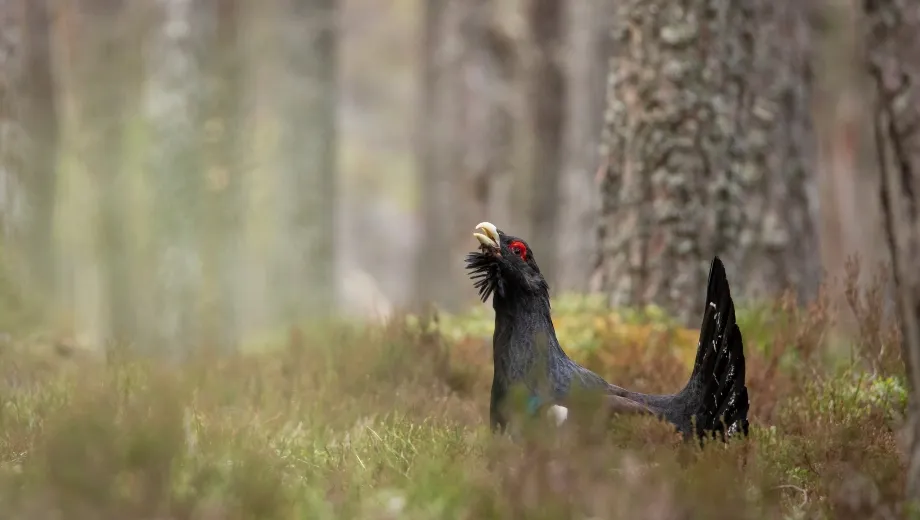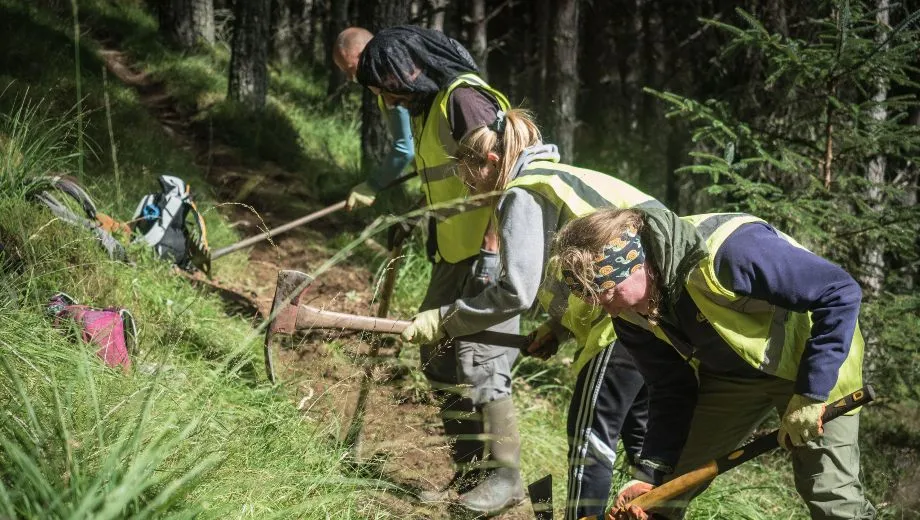Ride to the rescue
How can mountain bikers help one of the UK’s most threatened birds? The answer lies within the ancient pine forests of the Cairngorm National Park. Here they’re part of a team working to give the huge Capercaillie more of the space they so badly need.

On this page
Big birds
The name capercaillie literally means “horse of the forest”. But for geographer, environmentalist and mountain biker Douglas Carchrie, these iconic birds remind him of something much bigger.
Douglas said: “They’re pretty special, but because they’re so big, they’re actually quite scary - you’re not used to seeing something that big in the forest flying through the air. I always compare them to jumbo jets, they’re the jumbo jets of the forest world.”

Fallen Icon
Douglas is one of a small number of people in the UK who has ever seen a capercaillie in the wild. These huge birds, the biggest grouse in the world, are now so rare they’re rarely spotted and disturbing them is against the law. From around 20,000 Capercaillie in the 1970s living in forests across Scotland and northern England there are now only 542.
Their decline is not slowing, with a 50% fall in numbers in the last five years because of things like habitat loss, human disturbance and predation. Without dramatic action, they’re expected to be extinct in Scotland in the next 20 to 30 years.
Mapping Tracks
Douglas is part of the Cairngorm Capercaillie Project working to secure the long-term survival of the capercaillie. Over 85% of the remaining capercaillie live within the pine forests of the Cairngorms National Park and the project has been set up to encourage more people to get involved in helping them. This includes collaborating with different communities who live and visit the National Park.
For Douglas, his focus is the mountain bike community. Over the last year or so he has been riding his bike to map 250km of trails and tracks which wind their way through the pine-clad peaks and glens in the National Park. He took to the trails during the winter months to avoid any chance of disturbing Capercaillie.

Busy forests
The reason for mapping the tracks is that Capercaillie and mountain bikers love similar areas of the National Park. This creates challenges for the shy Capercaillie, especially during breeding season when they’re coming together to mate and raise young.
Douglas’ colleague and project manager Carolyn Robertson said: “Ultimately Capercaillie don’t want to be where we are. We can stress them out, push them into areas where it’s not the best habitat for them and we can cause populations to become isolated. If Capercaillie have less habitat available to them because of our activities, this can leave them more prone to the impacts of predation and human disturbance. They’re a species which ideally needs large areas of Scots pine-dominated woodland with minimal disturbance, but we have less of that habitat now and our forests can be relatively busy.”
Common ground
Working with Developing Mountain Biking in Scotland, the Cairngorms Capercaillie Project approached the mountain biking community in the Badenoch and Strathspey area of the Cairngorms National Park and found that the vast majority of mountain bikers cared about the environment they ride in and were willing to change behaviours to protect the environment.
Carolyn said: “Identifying such a high level of consensus was fantastic. It meant we’d found a community that was already on board and wanted to do the right thing but maybe didn’t always have the resources to make it happen. “
“Mind blowing” maps
The local Trail Association and other members of the local mountain biking community were keen to get involved and set up the brilliantly named Trail Feathers to work alongside the Cairngorms Capercaillie Project. Douglas’ maps were a key part of the initial assessment work to understand exactly how the two sets of forest dwellers were coming into contact.
Carolyn said: “The overlaid maps we produced were a bit mind blowing at first because the trails were so on top of the birds and the birds so on top of the trails. At first there seemed to be no wiggle room to create a more sustainable future for the birds and mountain biking. Capercaillie are such specialists, but mountain bikers are equally specialist in their own way. There was a lot of creative thinking about how to work within those parameters to try and give the birds what they need but also provide the mountain biking community with what they need to thrive too.”
New paths
The information collected from mapping the tracks has been an essential part of helping to create a long-term plan of action for the Trail Feathers group and local Trail Association to deliver, supported by the Cairngorms Capercaillie Project.
Douglas said: “One trail currently runs through a section of woodland bog which is a really important habitat for female capercaillie (hens) who rely on the cotton grass that grows there as a source of protein when they are breeding. But nobody wants to cycle through a bog, so we’ve made the decision to move the trail far enough away, so hens can access and use the bog without being disturbed.”
“We think it will be a true win-win, the capercaillie get some good habitat back and bikers get a better trail in a more sustainable place. Hopefully, it is going to work long-term for both forest users. We’re hoping to see evidence that simple changes like this can make a difference quite quickly. Trail cams have been set up on the bog to see if Capercaillie return."

Shifting gear
The Cairngorms Capercaillie Project in partnership with Developing Mountain Biking in Scotland, will continue to work with the Trail Feathers group and local Trail Association to deliver other aspects of the newly created long-term strategy, such as scoping new trails away from capercaillie hot spots, realigning existing trails and putting signage out for bikers to help increase awareness. Carolyn knows there’s still a lot of work to be done, but there is a feeling of optimism.
Carolyn said: “I feel like we met the local mountain biking community as equals and that’s helped us to learn an awful lot. Through the work we’ve been doing together it feels like some attitudes and beliefs have changed and we’re now on a slightly different and more sustainable path, which is great.”
For Douglas, a biker and a nature lover, he knows how important projects like this are to the future of the Capercaillie. He said: “Every time I see one, I think that’s amazing when you think how few are left. Last year I think I saw five, which when you think about it is 1% of the population. “It feels pretty good to be working for that species, it’s pretty special.”